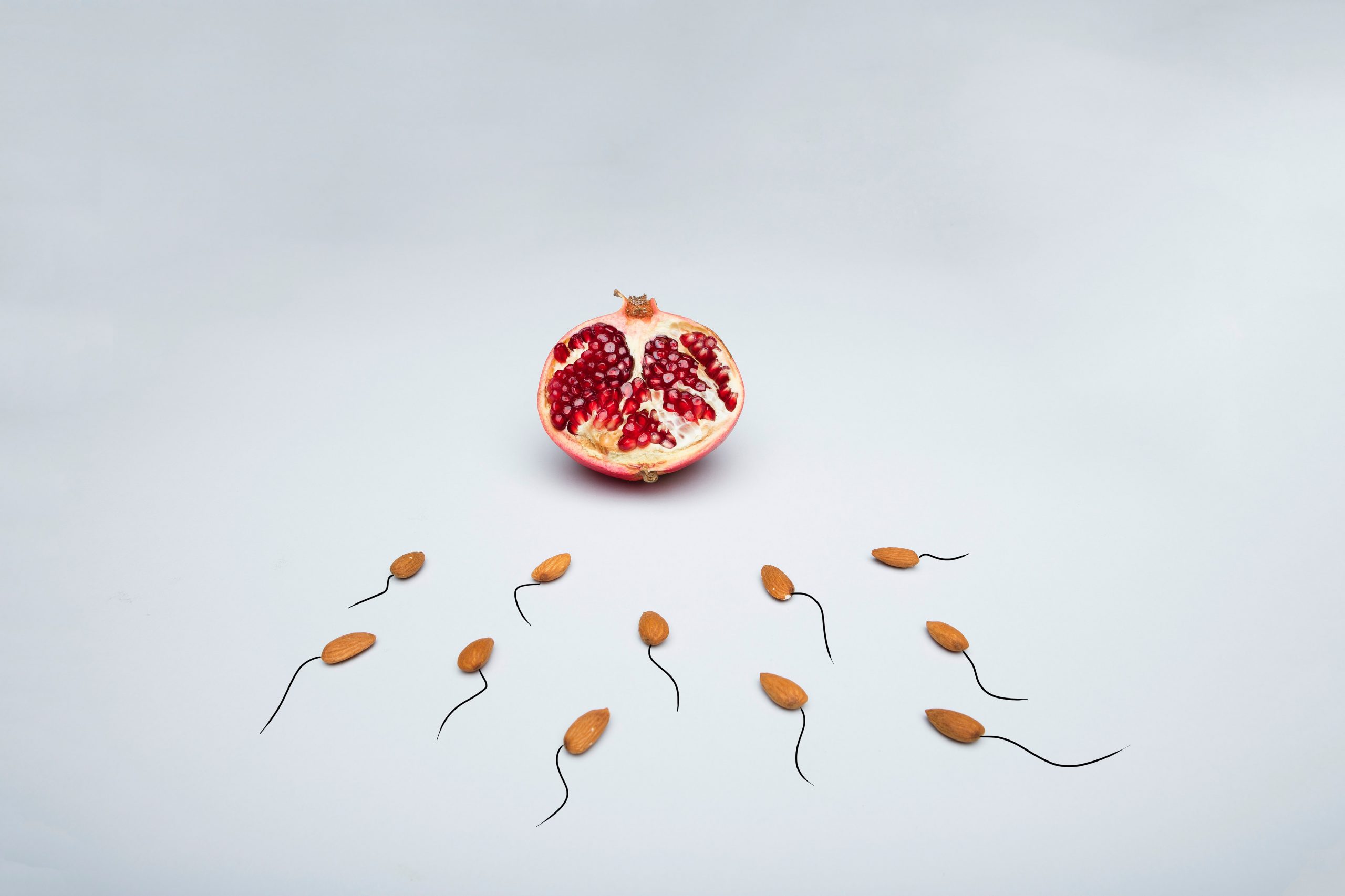Nutrition
Resources
Style
Planning
View All
Protein plays a vital role in supporting our health and wellness. Without proteins, our body would have trouble forming blood cells and other crucial structures, as well as regulating and maintaining its various functions.
A “high-protein diet” has become quite a buzzword in the health and the wellness field in recent years, especially in the realm of body-building or weight loss endeavors. As nutrition experts specializing in women’s health, we are going to specifically discuss the important relationship between sufficient protein intake and healthy pregnancy as well as potential impact for PCOS.
“I am currently pregnant- what should my protein intake look like?”
The current Recommended Dietary Allowance (RDA) for protein for adults is 0.8 grams of protein per kilogram of body weight. If a person weighs 154 pounds or 70 kilograms, 56 grams of protein would be the adequate daily intake.
However, for pregnant women, this recommendation is slightly different. Although the RDA for the first trimester remains the same as regular adults (0.8 grams per kilogram), the second and third trimester requires about 1.1 grams of protein per kilogram of body weight.
Furthermore, seafood consumption is highly recommended for pregnant women due to their positive association with young children’s cognitive development. Seafood is rich in healthy fats like Eicosapentaenoic acid (EPA) and docosahexaenoic acid (DHA).The recommendation is 8 to 12 ounces of various types of seafood that is low in methylmercury each week. High exposure to methylmercury is harmful to both the mother as well as the developing fetus.
Here are some of the best seafood choices (not an exhaustive list):
- Anchovy
- Atlantic mackerel
- Black sea bass
- Butterfish
- Catfish
- Clam
- Cod
- Haddock
- Salmon
- Oyster
- Sardine
- Shrimp
- Tilapia
- Canned tuna
- Lobster
On the other hand, here are the seafoods to avoid during pregnancy:
- King mackerel
- Marlin
- Orange roughy
- Shark
- Swordfish
- Tilefish (Gulf of Mexico)
- Tuna, bigeye
*From the FDA’s “Advice about eating fish”
Blood sugar balance and pcos
Insulin is a type of hormone that is secreted by the pancreas. When food is consumed, this hormone controls if the body wants to use or store the blood sugar. Previous studies have shown that with sufficient levels of insulin, protein does not increase blood sugar levels. This stabilizing effect was seen in patients with type 2 diabetes as well.
Furthermore there was also a study that suggested that a high protein diet is associated with lowering hemoglobin A1C levels (blood sugar level).
Studies have also shown that high protein and lower carbohydrate diets have led to a reduction in insulin resistance for women with Polycystic Ovary Syndrome (PCOS) who are also more prone to developing type 2 diabetes.
What are the high quality, high protein foods?
There are both animal and plant sources for protein.
Animal sources include meats, poultry, eggs, dairy and seafood. Plant sources include nuts, seeds, soy products, beans, peas, and lentils.
Processed and/or high-fat meats should be limited and instead fresh, frozen or canned forms of lean meat and poultry, seafood, and beans, peas, and lentils are recommended.
There is an increased interest in plant-based diets so here are some good plant-based protein sources:
- Dairy alternatives such as soy milk and fortified nut or pea milk
- Whole grains such as chickpea pasta, oatmeal, quinoa, or whole wheat bread
- Nuts and seeds such as almonds, hummus, peanut butter, tofu or chia seeds
- Vegetables such as broccoli, edamame, green peas or lima beans
The average American adult meets the required amount of protein consumption although this target is achieved (and even exceeded) mainly through animal based protein foods. Seafood and plant-based protein are categories that many Americans are lacking in.
Furthermore, despite the benefits that were mentioned in this article, it is important to keep in mind that more protein does not necessarily mean better. Overconsumption of protein has negative consequences as excess protein not only could get stored as fat but also could strain the kidneys as well.
Looking for more support?
If you would like more guidance as to what type of protein sources to incorporate in your diet as well as the adequate amount, check out our meal plans for more inspiration! We would love to support your journey.
References:
- “Advice About Eating Fish.” https://www.fda.gov/food/consumers/advice-about-eating-fish
- “Are You Getting Too Much Protein?” https://www.mayoclinichealthsystem.org/hometown-health/speaking-of-health/are-you-getting-too-much-protein#:~:text=Extra%20protein%20intake%20also%20can,people%20predisposed%20to%20kidney%20disease.
- Murphy MM, Higgins KA, Bi X, Barraj LM. “Adequacy and Sources of Protein Intake among Pregnant Women in the United States, NHANES 2003–2012.” Nutrients. 2021 Mar; 13(3): 795. doi: 10.3390/nu13030795 PMCID: PMC7997328 PMID: 33670970
- Dietary Guidelines for Americans 2020-2025, https://www.dietaryguidelines.gov/sites/default/files/2021-03/Dietary_Guidelines_for_Americans-2020-2025.pdf
- Dong J, Zhang Z, Wang P, Qin L. “Effects of High-protein Diets on Body Weight, Glycaemic Control, Blood Lipids and Blood Pressure in Type 2 Diabetes: Meta-Analysis of Randomised Controlled Trials.” Br J Nutr. 2013 Sep 14;110(5):781-9. doi: 10.1017/S0007114513002055. Epub 2013 Jul 5. PMID: 23829939
- Franz, MJ. “Protein: Metabolism and Effect on Blood Glucose Levels.” Diabetes Educ. 1997 Nov-Dec;23(6):643-6, 648, 650-1. doi: 10.1177/014572179702300603. PMID: 9416027
- Gannon MC, Nuttall JA, Damberg G, Gupta V, Nuttall FQ. “Effect of Protein Ingestion on the Glucose Appearance Rate in People with Type 2 Diabetes.” J Clin Endocrinol Metab. 2001 Mar;86(3):1040-7. doi: 10.1210/jcem.86.3.7263. PMID: 11238483
- “Insulin Basics”, https://diabetes.org/healthy-living/medication-treatments/insulin-other-injectables/insulin-basics
- Smith A, Colleen A, Spees C. “Wardlaw’s Contemporary Nutrition, 12th Edition.” McGraw Hill, 2022.
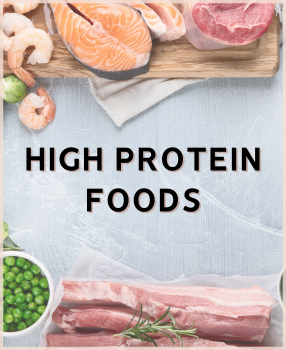
Oatmeal contains high levels of minerals, such as magnesium and zinc, in addition to fiber and B vitamins. This makes it a great food option if you are struggling with PCOS. Oatmeal can be your quick fiber-rich breakfast, an afternoon snack or eaten really anytime of day! The ingredients are minimal, and you probably have them in your pantry already. It’s a win-win.
Which type of oats is best for PCOS?
The less processed it is the better! Instant oatmeal is the most processed form of oats. Then it’s old fashioned oats and lastly steel cut oats. Steel cut oats have a sharper texture than old fashioned oats that some people don’t enjoy. If it’s your preference, old fashioned oats would still be a healthy choice!
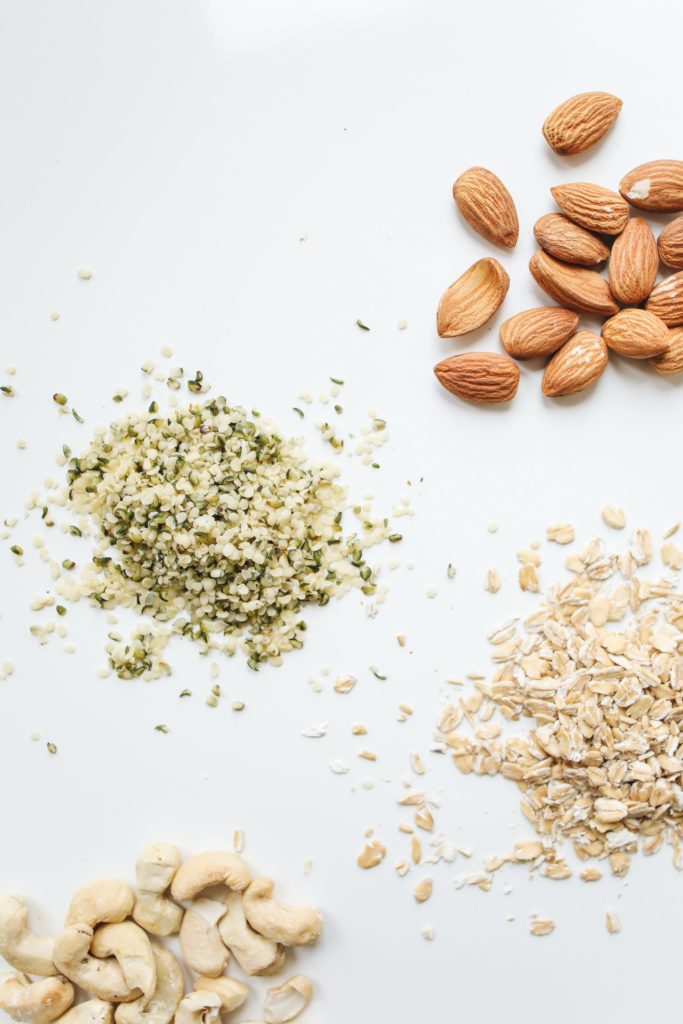
Which breakfast is best for PCOS?
The best breakfast for PCOS is well balanced with lean protein, healthy fats, and whole grains/complex carbohydrates. As a bonus you could even add in some veggies, like if you were having a smoothie or eggs.
Examples of lean protein choices for breakfast include:
- Eggs
- Nut butter (peanut, almond, etc.)
- Nuts and seeds (chia seed, ground flaxseed, etc.)
- Greek yogurt
- Leftover fish or chicken — Hey, who says breakfast has to be “breakfast food”? 😉
- Tofu
- Some plant-based milks with protein like Ripple
Healthy fats such as polyunsaturated and monounsaturated fats are also important in helping us to feel full. These fats give us energy to start the day off right! We can get these healthy fats from foods such as salmon, sardines, avocado, nuts (walnuts, pistachios) and seeds (for example chia and ground flaxseeds).
And last but not least, don’t forget the healthy carbs! Most women with PCOS think they have to avoid carbs and this is simply not true. Fruit, whole grains/complex carbohydrates are considered healthy carbs.
Best fruit choices for PCOS:
- Whole, fresh fruit – all kinds!
- Frozen fruit
- Most of the time frozen fruit does not have added sugar. So there is nothing wrong with eating frozen fruit.
- Dried fruit without added sugars
- Double check the nutrition facts label and try to avoid dried fruit with sugar.
- If it does have sugar remember this quick tip: Keep total added sugars under 25 grams per day for women.
Examples of whole grains/complex carbs for breakfast include:
- Whole grain bread or English muffin
- Oatmeal
- High fiber, low sugar cereal
- Low sugar granola
- Plantains/potatoes
Best Oat Recipes For PCOS

Chocolate Peanut Butter Cup Oatmeal:
1/4 cup rolled oats
1/2 cup unsweetened nut milk
1 tbsp all-natural peanut butter
1 serving chocolate protein powder
2 tsp ground flax seeds
1 tsp chia seeds
sea salt to garnish
Instructions:
Mix oats, flax seeds, chia seeds and nut milk in a bowl.
Microwave for 1-2 minutes
Stir in peanut butter and protein powder.
Top with a sprinkle of sea salt.
Looking for more Support?
Be sure to check out our Free Live Masterclass all about the top 3 ways to naturally enhance your fertility (perfect for those struggling with PCOS and hormone imbalances!)
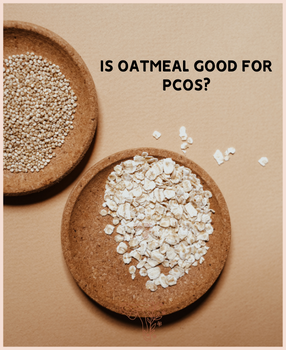
Ever wondered what steps you should take to optimize your nutrition before starting IVF?
Well wonder no more!
Here are 3 steps to preparing for your IVF journey
1.Take the time to optimize your lifestyle with your partner, whoever they may be!
It is important to keep in mind that dietary and lifestyle changes don’t happen overnight. Did you know that it takes approximately 3 whole months for both your eggs and sperm to fully mature? This really highlights why it is so important to spend at least 3 months prior to your first cycle of IVF making any required changes to your diet and lifestyle.
This may include:
- Optimizing your diet (I’ll go into more detail later in this blog post).
- Understanding your cycle. Speak to your fertility specialist or dietitian about your current menstrual cycle and ovulation. There are likely several strategies you can undertake to optimize and balance your cycle.
- Start or maintain a healthy, exercise routine. The current physical activity guidelines for adults state that you should aim to get at least 150-300 minutes of moderately intense exercise each week or 75-150 minutes of vigorous exercise each week for optimal health.
- Take steps to reduce your stress. Studies have repeatedly shown that chronic stress increases the level of inflammation in our body which increases oxidative stress and subsequent damage to the quality of our eggs and sperm. See my previous blog post for tips on how to reduce your stress!
2. Increase your consumption of dietary antioxidants!
One way you can do this is to adopt a Mediterranean-style diet. This pattern of eating has numerous benefits (particularly when it comes to fertility and IVF!).
It has been shown to:
- Improve both egg and sperm quality
- Increase embryo yields when you are undergoing IVF treatments
- Optimize fertility outcomes
- Enhance pregnancy outcomes (encourages carrying a healthy baby to full term with no complications)
- Decreases inflammation in the body thus improving both egg and sperm quality and increases the likelihood of conception
So what does a Mediterranean diet look like?
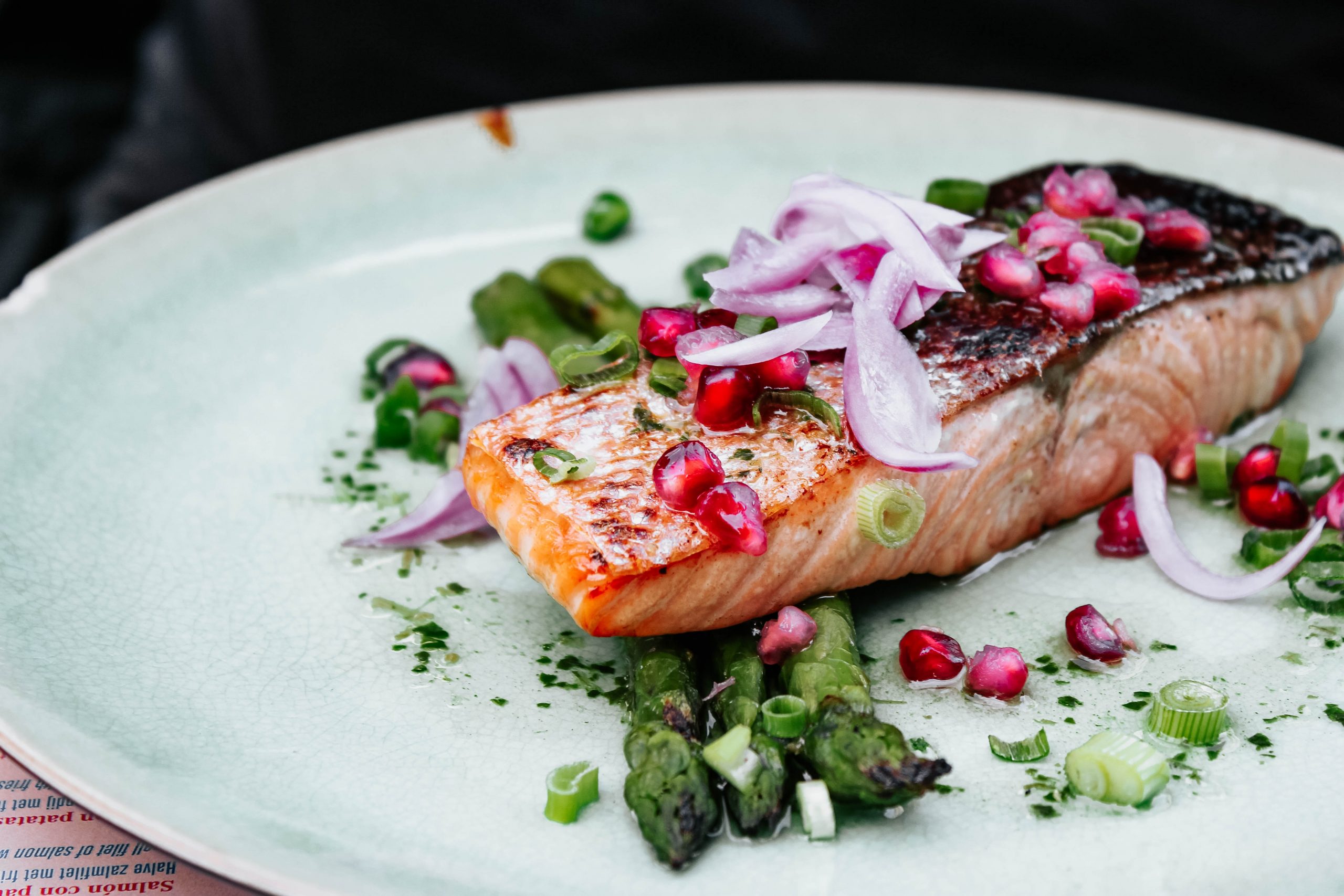
- Consuming plenty of colourful fruits and vegetables every day. A simple way to achieve this is to aim for at least 3 different colors on your plate at every meal!
- Consuming wholegrains (breads, cereals, rice, quinoa etc.)
- Cooking and using healthy fats like extra-virgin olive oil
- Eating a variety of different nuts and seeds
- Including legumes/beans in your diet (think of them like a vegetable with protein!)
- Plenty of seafood (with a particular emphasis on oily fish) at least twice each week
- Moderate consumption of dairy foods, eggs, and poultry (chicken, duck, turkey)
- Limiting your consumption of red meat
A Mediterranean style diet will ensure that you get all of the below nutrients that studies have shown are essential for quality eggs and sperm.
- Omega-3 fatty acids
- CoQ10
- Zinc
- Vitamin D
- Selenium
- Folate
- Vitamin E
- Vitamin C
- Lycopene
Studies have also shown that the wholegrains in a Mediterranean-style diet will aid the implantation of your fertilized egg!
3. Get a tailored supplement plan!
There are many ways that nutritional supplements can improve your chances of conceiving during IVF. However, it’s not as simple as taking your average prenatal.
A tailored supplement plan will take into account several factors including your:
- Age
- Medical history
- Reproductive history
- Current oral intake
- Weight and height
This will mean that you are taking supplements that have been individually tailored for your specific needs!
If you would like to learn how to optimize your nutrition before starting IVF, schedule your free 30 minute 1:1 strategy call with me!

References:
1.Mediterranean Diet 101: Meal Plan, Foods List, and Tips (healthline.com)
2. Maternal whole grain intake and outcomes of in vitro fertilization (nih.gov)
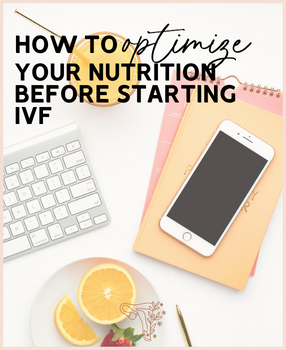
Like many of my clients and readers, I was given hormonal birth control with absolutely no discussion on the side effects of the pill. I was handed the pill and never really thought twice about it. I just knew it gave me a “regular” period and would help me protect against an unwanted pregnancy. It was only in my THIRTIES that I discovered how the pill depletes certain nutrients, affects mood, weight, and so much more. If you’re curious about which nutrients are depleted on hormonal birth control, then keep reading on.

8 Nutrients depleted on hormonal birth control and how they impact fertility:
Zinc
Found in foods such as eggs, seafood, meat, nuts, seeds, beans and whole grains. Zinc plays an important role in both egg and sperm health.
Magnesium
Found in foods such as avocado, banana, seafood, green leafy vegetables, nuts and seeds. Magnesium plays an important role in sleep, bone health and our muscles ability to relax.
Vitamin C
Found in foods such as oranges, broccoli, kiwi fruit and guava. Vitamin C is a valuable antioxidant that keeps our eggs and sperm protected from oxidative stress caused by free radicals.
Folate
Found in green leafy vegetables and fortified breads and cereals. Folate is essential when trying to conceive and helps to prevent the formation of neural tube defects in early pregnancy.
Selenium
Found in foods such as Brazil nuts, meats and seafood. Selenium plays a valuable role in our thyroid function and helps to prevent sperm from mutating or becoming damaged.
Vitamin B2
Found in eggs, meats and dairy products. Vitamin B2 is a common nutrient depleted when on the pill and is often the culprit behind those pesky headaches!
Vitamin B6
Found in foods like breads and cereals. Vitamin B6 is commonly depleted in those taking the pill. It plays an important role in fertility and the luteal phase of the menstrual cycle.
Vitamin B12
Found in foods such as fish, beef, and fortified cereals. B12 is essential for healthy cell formation, a must when trying to conceive.
Ideally you would want to ensure that these levels are checked and corrected where necessary before you start thinking about conceiving to ensure a healthy baby and pregnancy. You can start a prenatal, a few months before coming off the pill to help with the transition of coming off.
Wondering what else you can do to support your body when coming off the pill?
Let’s face it, coming off the pill can be a scary thought and can lead to some not so nice side-effects including:
- Post-pill amenorrhea
- Painful, heavy periods
- Irregular cycles that are hard to predict
- Acne
- Headaches or migraines
- Changes in weight (loss or gain)
- Changes to mood
- Digestive upset (IBS like symptoms)
- Breast tenderness
Supporting your body through nutrition can be a great way to make the transition easier.
Try these 9 tips to support your body when coming off the pill

- Aim to have at least 1 bowel movement each day to facilitate the removal of excess estrogen in the body.
- Eat plenty of cruciferous vegetables to lower estrogen levels – try eating 1 cup of bok or pak choy, broccoli, cabbage, cauliflower, arugula and Brussel sprouts each day!
- Eat regularly – aim to eat every 2-3 hours to support blood sugar and hormone balance. Putting your body under too much stress can increase the stress hormone cortisol.
- Eat enough fibre to encourage regular bowel movements – aim to eat between 3-6 cups of colourful, leafy vegetables each day.
- Eat lean protein to support your detox pathways – try turkey, chicken, pork, beef, and seafood.
- Include plenty of healthy fats to support hormone creation – try extra-virgin olive oil, avocado, nuts and seeds.
- Stay hydrated by drinking plenty of water – aim for at least 8 cups per day.
- Try to avoid highly processed foods – think sugary foods, fast foods and refined oils.
- Avoid alcohol if you can! Alcohol is also removed via our liver, so give it a break if you can.
References:
- How Birth Control Pills Affect Your Nutritional Needs – Scientific American
- Oral contraceptives and changes in nutritional requirements – PubMed (nih.gov)
Looking for more support with your fertility? Book your free 30 minute 1:1 strategy call with me to learn how I can support you using functional nutrition, specialty lab testing, and targeted supplements. Can’t wait to speak to you!

What is PCOS?
PCOS or Polycystic ovary syndrome is a medical condition that impacts a woman’s hormone levels. Keep reading to learn everything you’ve wanted to know about PCOS.
Those with PCOS typically produce more of the male sex hormones which can lead to:
- Hormonal imbalances
- Skipped or irregular menstrual periods
- Difficulties falling pregnant
- Cysts on your ovaries
Polycystic ovarian syndrome can also cause a range of symptoms including:
- Excess hair growth (particularly on the face and body)
- Changes in body shape
- Acne
- Balding or excess hair loss
Different types of PCOS
There are four main types of PCOS that we commonly see.
1. Insulin resistant PCOS
This is the most common type of PCOS. We can determine that you have insulin resistant PCOS by looking at your circulating insulin levels.
2️. Pill-induced PCOS
Unfortunately, birth control can mask PCOS and may cause symptoms once we stop taking it. When we cease birth control, there is a flood of androgens which while temporary which can cause a range of symptoms associated with PCOS.
3️. Inflammatory PCOS
Chronic inflammation in our body can see our ovaries produce too much testosterone, which we know is a common issue in PCOS!
4. Adrenal PCOS
If our bodies respond to stress in an abnormal way, we can see adrenal PCOS as a result. It is not as common, only making up around 10% of all PCOS cases. This diagnosis will see high levels of DHEAS (an androgen produced in the adrenal glands) and normal levels of other androgens.
How PCOS is diagnosed
A PCOS diagnosis is typically made by your medical team if you have at least two out of these three symptoms:
- Elevated androgen levels
- An irregular menstrual cycle
- Cysts on your ovaries
Your doctor may also:
- Conduct a pelvic exam to check the health of your reproductive organs
- Do an ultrasound to look for abnormal follicles or cysts on your ovaries
- Take your blood to test your hormones and a variety of other health indicators
Helpful PCOS labs to request
In your quest to learn everything you’ve wanted to know about your PCOS, it’s important to consider labs! There are several helpful labs that you can ask your doctor to request if you suspect you have PCOS or if you want to gain a clearer picture of how well you are currently managing your PCOS.
There are several hormones which may be contributing to your PCOS and are responsible for your symptoms including:
- Testosterone
- Estrogen
- Progesterone
- LH
- FSH
- Prolactin
- DHEA
It’s also helpful to understand your blood sugar levels and whether insulin resistance is an issue for you. You can ask your doctor to check your:
- Fasting glucose
- HbA1c
- Fasting insulin
Inflammation can be common in those with PCOS and thankfully with dietary and lifestyle changes, we can reduce this if we know it is an issue. As your doctor to check your:
- CRP
- Homocysteine
Metformin (a commonly prescribed PCOS medication) can cause B12 deficiencies, so ensure that you doctor screens for this in your bloods also!
How does PCOS impact your cycle?
There are two main ways in which PCOS impacts upon your menstrual cycle.
- Women with PCOS typically don’t ovulate or ovulate infrequently. This prevents the uterine lining from shedding each month like we would typically expect. As a result, this can cause irregular menstrual cycles.
- As a result of the above, the uterine lining doesn’t shed as often, becomes thicker and can cause heavier bleeding than normal when you do get a menstrual bleed.
What does PCOS mean in terms of fertility?
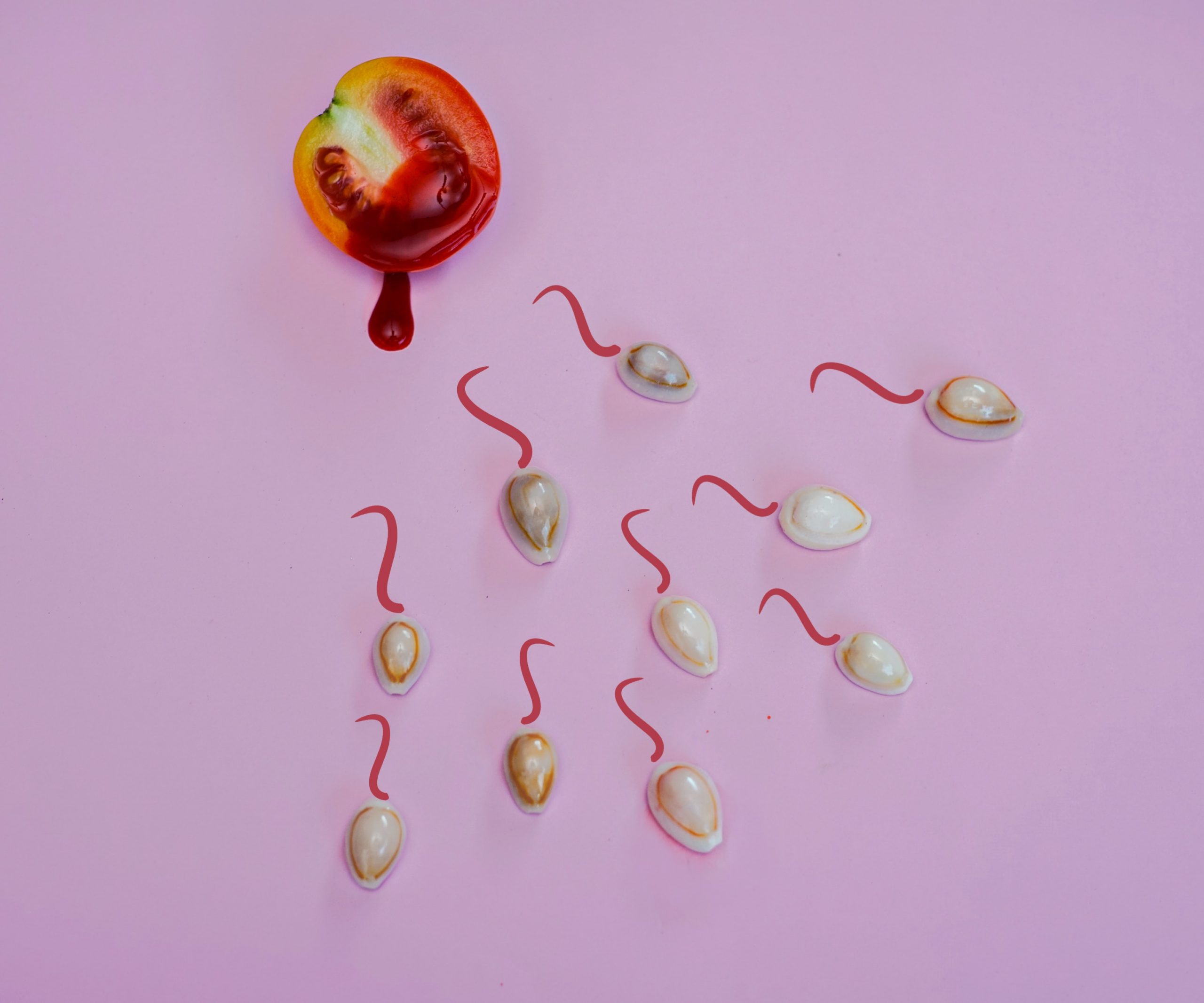
Given that PCOS disrupts your ability to have a normal menstrual cycle, it can also potentially impact upon your ability to get pregnant. It is estimated that between 70-80% of women diagnosed with PCOS struggle with infertility at some point.
The changes in hormone levels can also increase your risk of complications arising during your pregnancy including:
- Premature birth
- Miscarriage
- Gestational diabetes
- Pre-eclampsia
Thankfully dietary and lifestyle changes considerably improve your chances of conception and having a healthy pregnancy and healthy baby!
Things that can make your PCOS worse
- Working long hours and not taking regular breaks
- Inadequate water intake
- Inadequate daily movement or exercise
- Not eating enough fibre
- Poor sleep duration and quality
- Drinking too many caffeinated beverages
- Not eating enough healthy fats in your diet
- Not eating regularly – skipping meals and snacks can wreak havoc on your blood sugar and insulin levels
- Exposure to endocrine disrupting chemicals
- Not eating balanced meals
- Consuming too many processed foods
How best to support your PCOS
The good news is that there are many aspects of your lifestyle that can be altered that can significantly improve the free androgen index (FAI), in addition to your weight and BMI.
Aim to balance your blood sugar levels and manage your insulin resistance
- Consuming low-glycaemic index foods (see guide here for more info)
- Eat regularly (every 3-4 hours)
- Consume balanced meals (incorporate protein, healthy fats and fibre-filled carbohydrates into each meal and snack)

Consider supplements
- Talk to your healthcare profession about how dietary supplements may be able to assist in the management of your PCOS (see more on supplements for PCOS below)
Manage your stress
- Adopt strategies to better manage your stress
- Try moving your body, meditating, and journaling

Drink enough water
- Aim for at least 8 glasses of water each day
Get plenty of sleep
- Aim for 7-8 hours sleep each night
Avoid endocrine disrupting chemicals
- Avoid BPA, phthalates, dioxins, copper and chromium are just some of the many endocrine disrupting chemicals we are exposed to each day.
Endocrine disrupting chemicals are found in:
- food
- personal care products
- cosmetics
- pharmaceuticals
- pesticides
- plastics
- water
- soil
Learn more about endocrine disruptors here.
Some commonly used supplements include:
Magnesium
The research on magnesium supplementation is not concrete at present. Some studies suggest that magnesium may play a role in improving insulin resistance due to its links to glucose metabolism.
Inositol
Inositol is often combined with metformin and can help to enhance:
- Insulin function and manage insulin resistance
- Move glucose into our cells faster helping to keep our blood sugar levels more stable
Berberine
Berberine is known for having several functions including:
- Helping to reduce inflammation
- Increase insulin sensitivity
- Encouraging ovulation each cycle (in turn improving fertility)
N-Acetyl Cysteine (NAC)
NAC is an antioxidant compound which reduces the number of free radicals that can damage cells in our body.
NAC is associated with:
- Improved chances of conceiving
- More regular ovulation
Enjoyed learning everything you’ve wanted to know about PCOS and keen to learn more?
References:
- Treatment of infertility in women with polycystic ovary syndrome: approach to clinical practice (nih.gov)
- Pregnancy complications in women with polycystic ovary syndrome | Human Reproduction Update | Oxford Academic (oup.com)
- Polycystic Ovary Syndrome (PCOS): Symptoms, Causes, and Treatment (healthline.com)
Harnessing the Power of 5R’s for Optimal Gut Health
If you’ve read my other posts about how gut health is so important for fertility, then you’re probably wondering how you can approach the process of healing. Enter: the 5R Framework for Gut Healing.
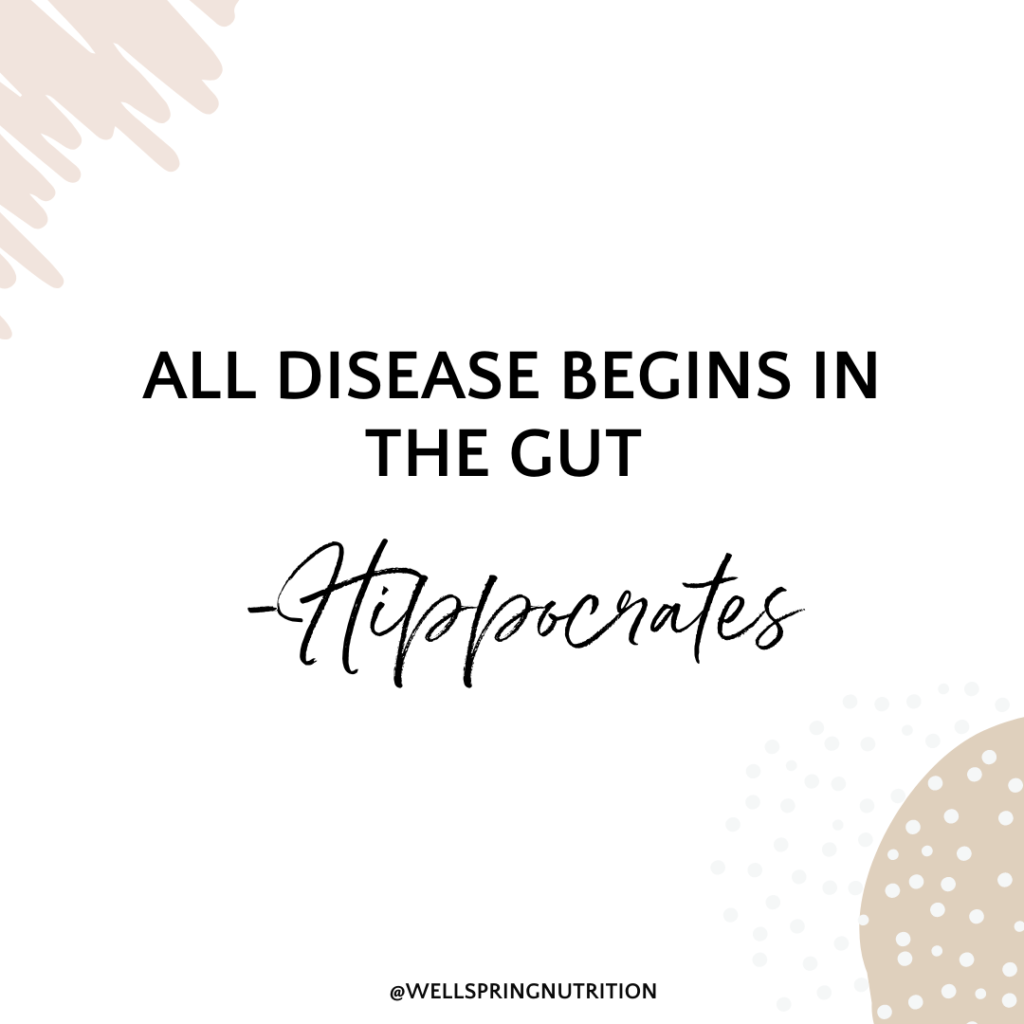
*While I recommend working with a health practitioner to help guide you through this process, I thought I’d break down a very popular approach to healing the gut. Please know that an individualized approach is best when trying to heal digestive issues.
Why address gut health first?
Dysfunction of one’s GI system can have a downward spiral effect on overall health. From a functional lens we recognize the interconnectedness between:
- Digestion / Absorption
- GI Flora- balance vs dysbiosis
- Immune regulation and inflammation
- Gut brain axis
- Enteric nervous system
- Intestinal Permeability
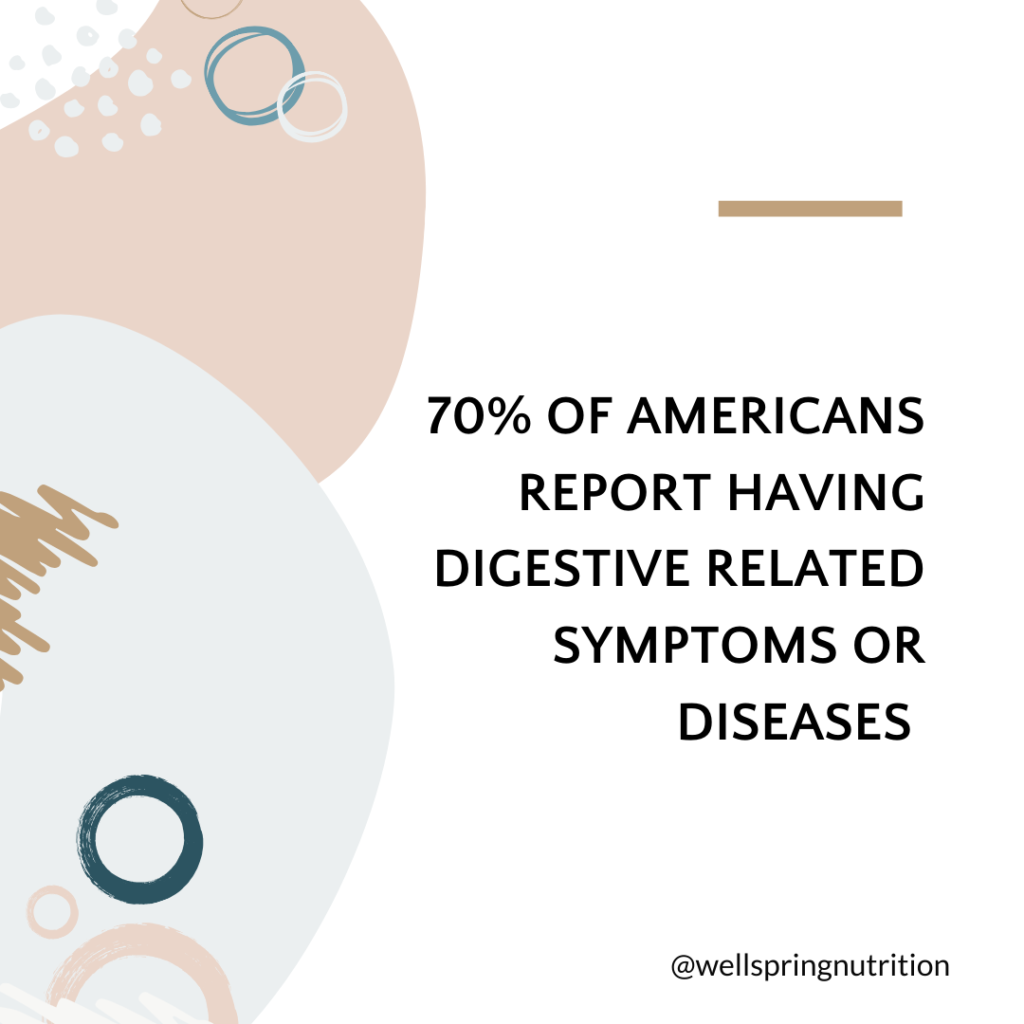
Going beyond just poor digestion, the gut brings the whole body in balance. The gut is the body’s second brain and is ground zero for our immune system.
The GI track makes 75% of neurotransmitters, contains ⅔ of immune tissues, contains 10x more cells than rest of body combined, houses genome 100x larger than human genome, and has a metabolic activity greater than the liver.
So, where do we begin?
Of course, with the diet. Our gut health depends on eating a nutrient-dense diet, full of fiber, and diversity (think about getting 30 different plant sources of food per week!)
You can’t expect to feel like a million bucks if you’re eating from the dollar menu.
Eating a Standard American Diet (SAD) puts you at higher risk for a leaky gut (intestinal permeability) and dysbiosis. If you’re eating junk, you probably feel like junk, just sayin.
Other things that impact gut health are antibiotics, infection, genetics, sleeping habits, environmental toxins, stress, and exercise.
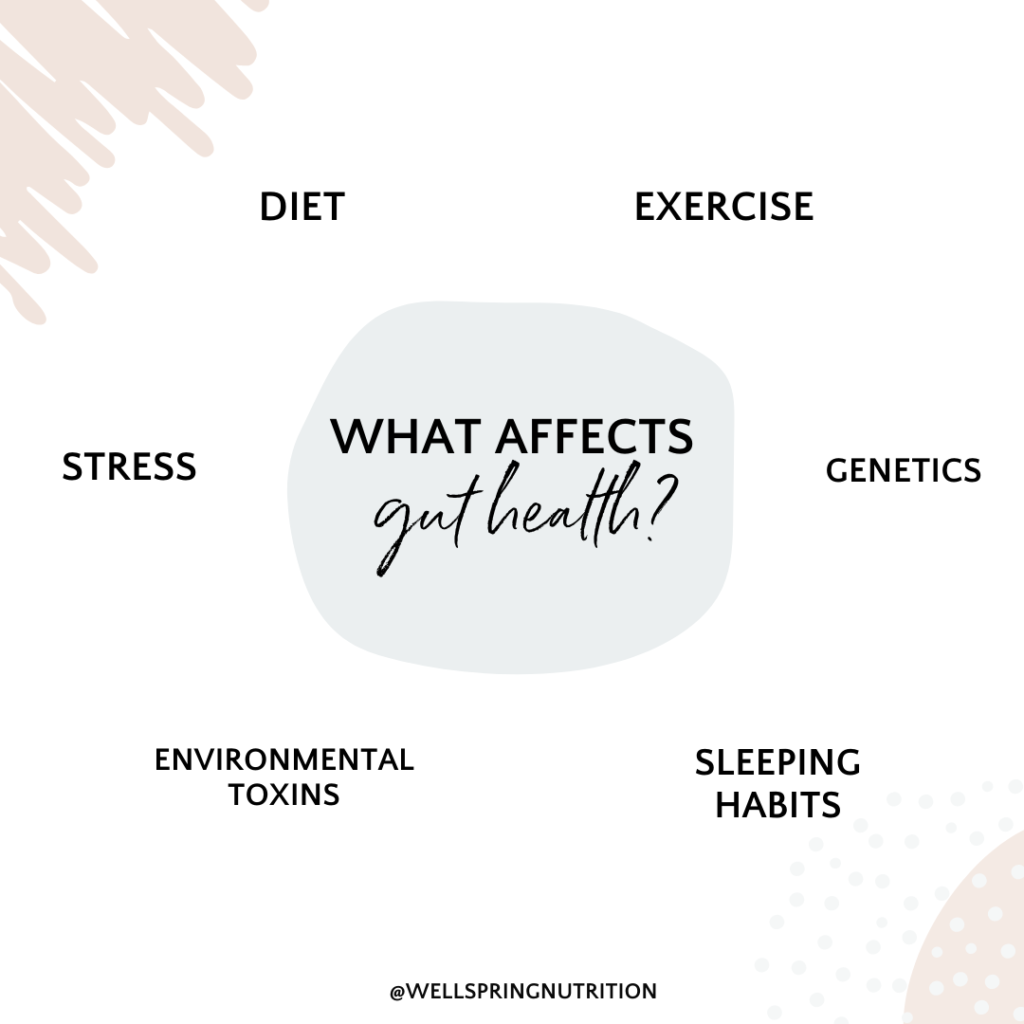
Our gut microbiota are responsible for may things, including:
- Digestion of lactose and proteins
- Balance intestinal pH
- Benefits to bowel habits – microbiota can help IBS symptoms, alleviate diarrhea, and peristalsis
- Reduce intestinal inflammation and are immune strengthening. (Good bacteria can prevent infections.)
- Essential Fatty Acid and Short-Chain Fatty Acid production
- Conversion of flavonoids
- Protecting against pathogens (food infections, and can decrease severity of an infection)
- Break down toxins and protect against toxic burden
- Protect and modulate autoimmune diseases
The 5R Framework for Gut Health:

- Process to help reduce inflammation and help to heal the gut
- Targeted, individualized intervention
- Process to normalize critical gastrointestinal functions
Remove
REMOVE:
- Foods to which an individual is sensitive, intolerant or allergic (elimination diet, food journal, and detailed history — food is information!)
- Poor quality, processed foods
- Pathogenic microflora (bacteria, fungi, parasites)
- Toxins, chemicals, environmental stressors such as pollutants
- Chronic stress
This step is really not about losing weight, calorie restriction, or removing food groups just for the sake of it. This is about identifying food sensitivities and triggers, honoring your body’s hunger cues, and really about the QUALITY of fuel you’re eating.
Replace
- Providing support for proper gastric acidity
- Betaine HCL tablets taken with protein meals (if you have low stomach acid)
- Digestive enzymes with acid pH range
- Digestive bitters
- Apple cider vinegar
- Lifestyle factors — reduce stress, increase exercise, sleep

Re-Inoculate
This stage is about a supportive reintroduction of beneficial GI microflora (pre-biotics, probiotics, etc.) to achieve a more desirable balance to intestinal microbiome.
Some people may find out that they have too much of one type of bacteria, and not enough of another. Doing a GI MAP functional gut health test is an excellent way of identifying this.
Also, include more fermented and cultured foods into the diet to add more beneficial bacteria.
Repair
This step is all about providing nutritional support for healing and regeneration of the GI mucosa. Some things to consider would be:
- Glutathione
- Vitamins A, D, C and E
- Zinc
- Slippery elm or marshmallow root for mucosal support
- Immunoglobulins for GALT function (gut-associated lymphoid tissue)
- Phytonutrients and anti-inflammatories like curcumin, EPA and DHA
Rebalance
The last step is all about rebalancing- this means anything from scheduling relaxation time, to eating more mindfully and reducing stress.
Other helpful techniques include yoga, meditation, breath-work or psychotherapy. In fact, a recent study showed that when looking at hypnotherapy compared to the low FODMAP diet, they both had similar results for people with IBS.
Similarly, a study looking at 12 weeks of the low FODMAP diet vs. 12 weeks of gut-directed yoga therapy found that the yoga flow had similar outcomes as the low FODMAP diet, which is considered the gold standard diet for people with IBS.
This research is still new and emerging, but stress no doubt plays a huge role in gut health.
If you’re interested in learning more about functional gut health testing, or how I work with my fertility clients on gut health – feel free to book a free 30 minute call with me to see how I may be able to help you on your journey.
Please Note: The information on this website is provided for educational purposes only and should not be construed as medical advice. Please consult with your healthcare practitioners before undertaking any changes in your diet or adding supplements.
References
Intestinal Microbiome in Irritable Bowel Syndrome before and after Gut-Directed Hypnotherapy. (2018) https://www.ncbi.nlm.nih.gov/pubmed/30453528
Hypnotherapy Provides IBS Relief (2019) https://jamanetwork.com/journals/jama/article-abstract/2722766
Randomised clinical trial: yoga vs a low-FODMAP diet in patients with irritable bowel syndrome (2018) https://www.ncbi.nlm.nih.gov/pubmed/29076171
The Preconception Playbook
This free playbook provides specific actionable tips to get started on your fertility journey, as well as what to avoid while you're trying to conceive.
Get the free playbook

